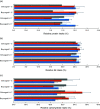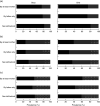A multilevel analysis of the relationship between parental migration and left-behind children's macronutrient intakes in rural China
- PMID: 26641518
- PMCID: PMC4974629
- DOI: 10.1017/S1368980015003341
A multilevel analysis of the relationship between parental migration and left-behind children's macronutrient intakes in rural China
Abstract
Objective: China's internal migration has left 61 million children living apart from their parent(s) in rural areas. The present study aimed to examine whether the relative contributions of macronutrients (protein, fat and carbohydrate) to total energy intake differ between children left behind by the father or mother, compared with children from intact families.
Design: Drawing on a longitudinal study, the China Health and Nutrition Survey (1997-2009), multilevel modelling analyses (level 1: occasions; level 2: children; level 3: villages) were performed.
Setting: Data from rural communities in nine provinces in China.
Subjects: Rural children (n 975; 555 boys and 420 girls) from 140 villages.
Results: Among boys of school age, being left behind by the father tended to reduce the relative protein intake by 0·70 % (P<0·01) compared with boys from intact families. Being left behind by at least the mother was more detrimental for young boys under the age of 6 years than paternal migration, reducing relative protein intake by 1·14 % (P<0·05). Parental migration was associated with a significant increase in young boys' relative fat intake by 2·60 % (P<0·05). No significant associations were found for girls. Results suggest left-behind boys, especially in early life, are subject to a higher-fat and lower-protein diet compared with non-left-behind boys. This may put them at increased risk of being overweight or obese, or of suffering from stunted growth, when they grow up.
Conclusions: Public health policies should recognise the influences of parental migration on boys, especially maternal migration, and encourage a more balanced diet for children in rural China.
Keywords: China; Gender; Left-behind children; Malnutrition; Nutritional intakes.
Figures

 , by at least mother;
, by at least mother;  , by father only;
, by father only;  , non-left-behind) in rural China. Values are means, with their standard errors represented by horizontal bars; China Health and Nutrition Survey, 1997–2009
, non-left-behind) in rural China. Values are means, with their standard errors represented by horizontal bars; China Health and Nutrition Survey, 1997–2009
 ), below (
), below ( ) and above (
) and above ( ) the Acceptable Macronutrient Distribution Range for (a) protein, (b) fat and (c) carbohydrate by left-behind patterns for boys and girls aged 1–17 years in rural China; China Health and Nutrition Survey, 1997–2009
) the Acceptable Macronutrient Distribution Range for (a) protein, (b) fat and (c) carbohydrate by left-behind patterns for boys and girls aged 1–17 years in rural China; China Health and Nutrition Survey, 1997–2009References
-
- All-China Women’s Federation (2013) Research report on left-behind children and migrant children in China. http://acwf.people.com.cn/n/2013/0510/c99013-21437965.html (accessed September 2015).
-
- Ning M & Chang H-H (2013) Migration decisions of parents and the nutrition intakes of children left at home in rural China. Agric Econ Czech 59, 467–477.
-
- Chen C, He W, Wang Y et al.. (2011) Nutritional status of children during and post-global economic crisis in China. Biomed Environ Sci 24, 321–328. - PubMed
MeSH terms
Substances
Grants and funding
LinkOut - more resources
Full Text Sources
Medical

